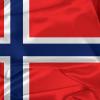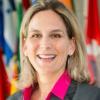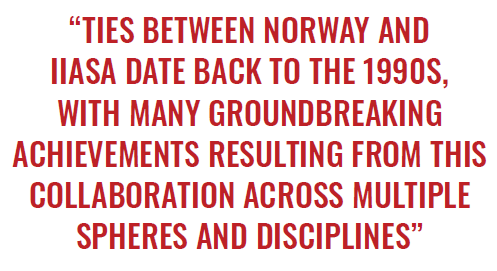
Options Magazine, Winter 2023: IIASA and Norway have enjoyed fruitful collaboration spanning multiple sectors for over two decades, helping to shape the political discourse at national, regional, and global levels. Represented by the Research Council of Norway, the country has been among the most active contributors to the work of IIASA.
“Ties between Norway and IIASA date back to the 1990s, with many groundbreaking achievements resulting from this collaboration across multiple spheres and disciplines,” says Thomas Hansteen, Special Adviser at the Research Council of Norway, representing the country at the IIASA Council. “Systems analysis is a powerful tool, which can help the global community tackle a variety of contemporary challenges — from fighting air pollution to safeguarding the Arctic”.
Key areas of research between Norway and IIASA include, among others, identifying strategies to address air pollution and greenhouse gas emissions to mitigate climate change, examining the impacts of climate change and infrastructure projects on Arctic populations, evaluating methods to preserve biodiversity, and examining pathways toward a circular economy.
ANALIZING AIR POLLUTION AND CLIMATE CHANGE
Climate change and air pollution are two problems at the very heart of the IIASA-Norway research collaboration. Most notably, through analysis of particulate matter concentrations across Europe, IIASA researchers and Norwegian colleagues compiled the data and helped to warn policymakers that under current legislation, air pollution hotspots will remain in Eastern Europe, Southern Poland, and some major European cities.
IIASA also seeks to identify ways to fill such policy gaps. Numerous studies have used the IIASA integrated assessment models, including the Greenhouse Gas and Air Pollution Interactions and Synergies (GAINS) model, to explore potential strategies of simultaneously cutting air pollution and greenhouse gas emissions. As part of this work, the Norwegian Meteorological Institute and IIASA supported the revision of the Ambient Air Quality Directive, having developed respective air pollution scenarios that formed the basis for the developed proposal. In the past, the GAINS model was also applied to draw up the Convention on Long-Range Transboundary Air Pollution — one of the first international treaties that helped Europe slash air pollution.
PRIORITIZING BIODIVERSITY
The IIASA-Norway collaboration focuses on a variety of other pressing issues within the realm of environmental politics. With partners from the Norwegian University of Science and Technology (NTNU), IIASA researchers are supporting stakeholders to produce innovative policy pathways to improve biodiversity across Europe. As part of this work, they are applying the latest modeling tools to understand the impact of worldviews and differing equity principles on biodiversity policy outcomes.
Another project, co-developed with partners from the Norwegian Institute for Water Research, addresses the limited availability at the EU-scale of harmonized, longterm, spatially explicit, and regularly updated biodiversity data. The project seeks to increase the availability of such data and ultimately mitigate biodiversity loss by closing knowledge gaps, thereby helping to formulate new transformative policy options.
Norwegian institutes also support other large-scale initiatives at IIASA, such as the Food, Agriculture, Biodiversity, Land-Use, and Energy (FABLE) Consortium, which seeks to establish a model-aided decision-support environment for sustainable development pathways in the land use space. Through the adoption of a holistic approach, FABLE helps to analyze a mixture of different factors across a variety of spheres to advance transitions towards sustainable food and land use systems, while taking into account biodiversity preservation and global energy concerns.
SAFEGUARDING THE ARCTIC AND ITS POPULATIONS
Arctic temperatures have risen at twice the global average rate over the past few decades, which impacts both fragile Arctic environments and the livelihoods of local populations. The IIASA-Norway collaboration explores the effect of climate change on Arctic permafrost and its socioeconomic impacts, as well as causal factors such as black carbon emissions, which accelerate Arctic permafrost meltdown. Black carbon is produced by incomplete burning of wood and fossil fuel and upon landing on snow or ice, it tends to absorb heat from the sun, increasing the rate of melting. IIASA collaborates with the Norwegian Institute for Air Research (NILU) and other institutions to analyze this problem and explore potential black carbon emission reduction strategies.
In addition, in partnership with Norwegian experts, IIASA researchers contribute to a variety of other projects focusing on the protection of Arctic populations and environments including a project that focuses on how indigenous and non-indigenous residents of the Arctic, including in Norway, engage with new and upgraded infrastructure in the region, examining the intended and unintended consequences.
ACHIEVING A NET-ZERO EMISSION CIRCULAR ECONOMY IN THE EU
The NTNU also collaborates with IIASA on integrating circular economy and climate mitigation strategies, for example, as part of the CircEUlar project. Researchers from IIASA, NTNU, and other partners develop new modeling approaches for analyzing circularity from a systems perspective in order to broaden the understanding of dynamics and levers for societal transformation toward a net-zero emission circular economy.
“Together with colleagues from NTNU, we are mostly collaborating on combining energy systems and materials modeling,” explains Volker Krey, Integrated Assessment and Climate Change Research Group Leader in the IIASA Energy, Climate, and Environment Program and Adjunct Professor at NTNU. “Looking at it from a solutions perspective, we combine the circular economy and climate change mitigation research agendas with the ultimate goal of catalyzing the transition toward a circular economy and net-zero emissions”.
TRAINING YOUNG PROFESSIONALS
Young Norwegian scientists have had opportunities to hone their skills in systems analysis through various IIASA capacity building activities. Four researchers from Norway worked at IIASA in the past five years, three of which were participants in the Young Scientists Summer Program (YSSP).
PATHWAYS TO FUTURE COLLABORATION
In light of the realities of a changing climate, cooperation between scholars from all over the world is as crucial as ever. Having enjoyed many years of working together with Norway and other countries all over the world, IIASA endeavors to bring together the best specialists, as well as train a new generation of young scientists to work together to find solutions for the global challenges facing our world today.
By Vladimir Tarakanov

